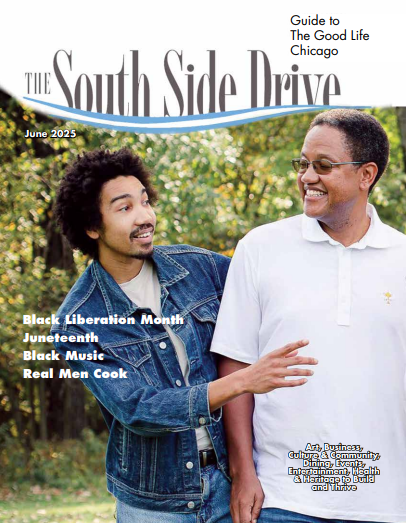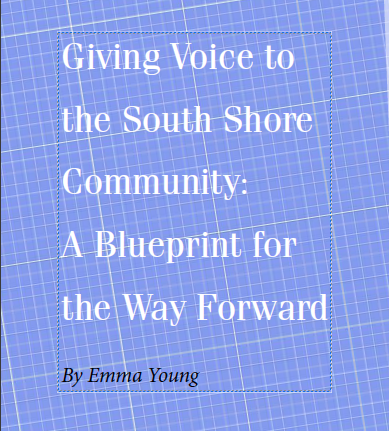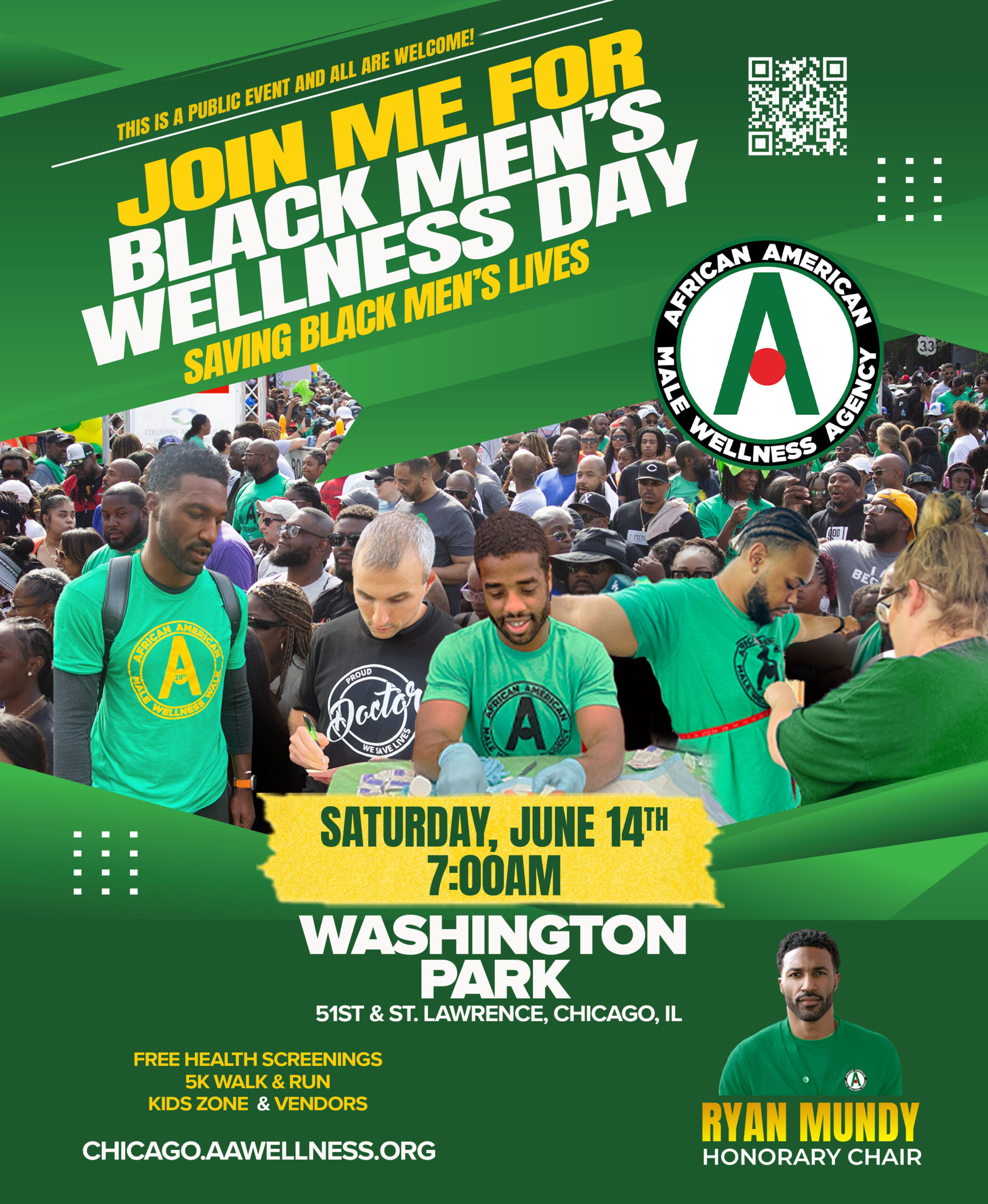Eva Maria explains, “There is clearly a correlation between economic opportunity and the infrastructure that results in gun violence, like selling drugs. Why do people sell drugs? They need money.”
The South Shore Community was once the home of middle-class and affluent Black people. There areas in South Shore, such as, “Pill Hill” named for the doctors who occupied the area’s very expensive homes and Jackson Park Highlands, where mansions with coach houses and huge ballrooms housed the very affluent Black upper class. However, things changed swiftly.By the late 1990’s, the community was bereft of amenities and resources, and, like most of Chicago’s South Side, had become a virtual haven for crime and violence.
Eva Maria Lewis, although born in South Shore, attended Andrew Carnegie Elementary School, a school for gifted children, which was outside of South Shore. In high school, she attended Walter Payton College Prep, rated number one in the country, and located on the North Side of Chicago. As a senior in high school, she noticed the vast difference between Chicago’s North Side and South Side. She realized that the students up north had access to resources that weren’t available to many South Side families, like grocery stores and schools within walking distance. “That’s when I reached out to Bouchet Elementary School in South Shore and asked them what they needed and began to fundraise for them,” she told us.
At the age of nineteen, Eva Marie realized something was very wrong in her community. She explains, “Being from the hood and growing up experiencing poverty, but also having this juxtaposed position where I was in these spaces where the people were very privileged and had resources, I knew that the only difference was rooted in race and class. And just because they had it and we didn’t, didn’t mean we didn’t deserve it.” She knew that something had to be done, and that “something” began with giving South Shore a voice.
At the age of nineteen, then only in high school, Eva Maria founded the Free Root Operation, of which she is the Executive Director. She began collecting data to find out what the community wants and needs. Although the Obama Foundation sponsored the start of the data collection, Eva Maria makes it clear that does not mean Free Roots is in alignment with some of the things that are happening in the community. She notes, “The point of the data collection is it’s unbiased. That’s what data is.”
She began posting online, asking people to help canvass the community. “Not all of the people who were canvassing were from South Shore,” she says. “They came from all over the city, volunteering to collect this data,asking people what South Shore needs.”
The canvassers talked to over five hundred South Shore residents, fifty of whom were parents of children who attended Bouchet Elementary School. Volunteers went all over the community with their clipboards and papers, asking people what they need and what they want their community to look like. The majority of the data and solutions came from the 500+ respondents. Only fifty Bouchet Elementary School parents filled out the Community Needs and Assets Assessment (CNAA), which also asked for age and gender. Since the sample size for the CNAA is a lot smaller, the demographics are not indicative of everyone they talked to for all of the data.
The survey culminated in a forty-four-page booklet which will be available on October 8, 2021, online and in person at all of the disbursal sites. The disbursal sites will be announced on October 8 on the website, www.freeroot. com.
The list is not finalized, but Free Root is currently working with a number of organizations and businesses in the South Shore area that have agreed to be disbursal sites, which include:
The Quarry Chi
2423 East 75th Street
Majani Restaurant
7167 South Exchange
Don Nash Community Center
1833 East 71st Street
The survey consisted of three sections: Education, Safety, and Leisure. Education was further divided into two segments: Economic Opportunity and Youth Development.
Many of the respondents to the Education segment said they were not working in the profession from which they received their degree. And the adult respondents also said their level of education did not match what they were currently doing. They found that their college degree did not provide opportunities to make the amount of money they wanted to earn.
Many parents said their children had to leave the neighborhood to study for the ACT or SAT tests instead of studying for them in South Shore. Many parents, especially those from Bouchet, said they want more afterschool programs to engage their children.
In terms of youth in general, Eva Maria recalled talking to a large group of young people on 71st Street. She said they were complaining about how there was nothing for them to do in the summer. She said, “The kids felt like the only thing they could do is be on the streets. They also felt that when programs are set up for young people, they are not accessible to everybody, because many programs don’t know how to deal with kids who might have some behavioral issues or who might be a bit impatient. Therefore, they felt these kids felt rejected and turned away from what was available.” In terms of solutions to crime and violence, Eva Maria states, “Our mission is to combat gun violence through compassion and opportunity, and so basically, although there was a section in the booklet that does say “Safety,” from our framework and our mission, everything in the booklet has to do with safety and gun violence because we believe that gun violence results from a lack of resources and a lack of infrastructure in the neighborhoods.” She adds, “That’s why the data was collected in the first place, to really imagine what a community where we all feel safe would look like.”

Economic opportunity was the primary concern of the respondents, while Safety was the second concern. Eva Maria explains, “There is clearly a correlation between economic opportunity and the infrastructure that results in gun violence, like selling drugs. Why do people sell drugs? They need money.”
Although safety was mentioned often, people did not have any solutions to keep community residents safe. Eva Maria tells us, “Everyone said this was their concern. People had opinions about it, and those opinions were split – some people said we need more policing, some people said we need no policing. But just because they didn’t offer a solution that was specifically oriented to safety does not mean they didn’t have a solution that could affect safety.”
The category with the most solutions was the Leisure category, which was the third most mentioned. Eva Maria points out, “I wanted to make sure we collected information on leisure because people don’t know that leisure is a human right from the Universal Declaration on Human Rights created by the United Nations in 1948.”
The Leisure section took up two pages. Respondents said they wanted swimming pools, roller skating, sports, robotics, gardening clubs, movie theaters, restaurants, and shops. What is interesting is that no one, not one person mentioned that they wanted snow sledding or a snow sled mount, although the Obama Center plans include closing Cornell Avenue to accommodate a snow sled mount.
Eva Maria, an only child, was raised by her mother. “She sacrificed for me,” Eva Maria states. “It came at the expense of economic sustainability because her job moved. And now God is rewarding that sacrifice she made for me.”
Ultimately, Eva Maria wants to positively affect people. “I want to help people get free mentally, physically, and spiritually, because I feel a big circumstance with our people is we don’t realize what we deserve and that’s because of what society has done to us. So, I just want to empower people to imagine better for themselves and to pursue that betterment.”







